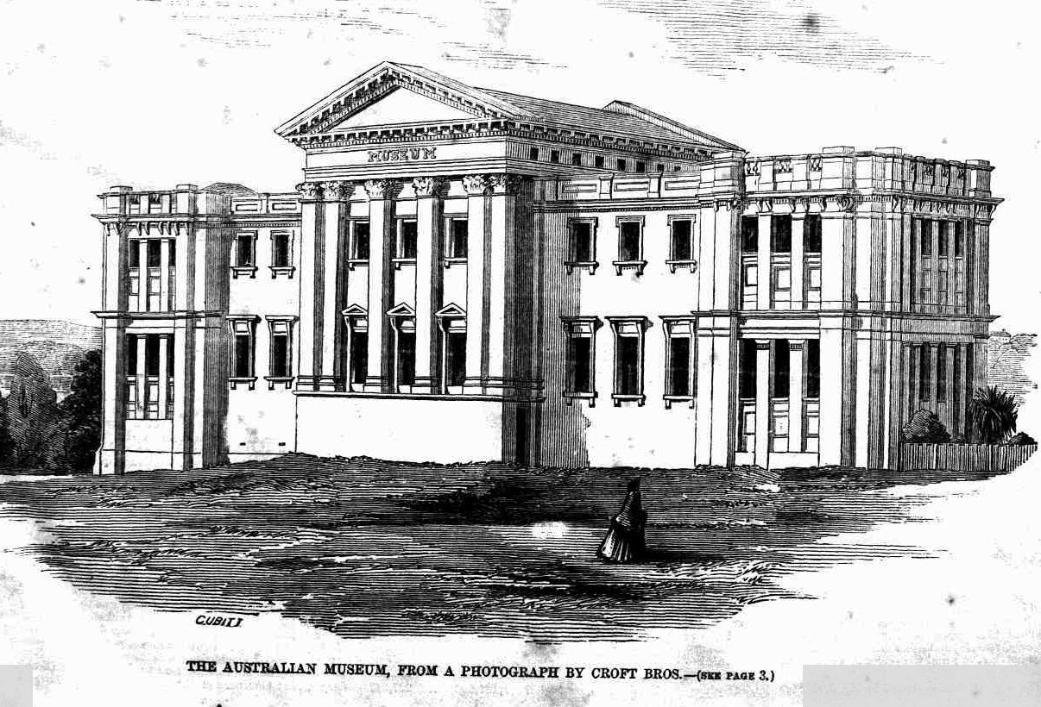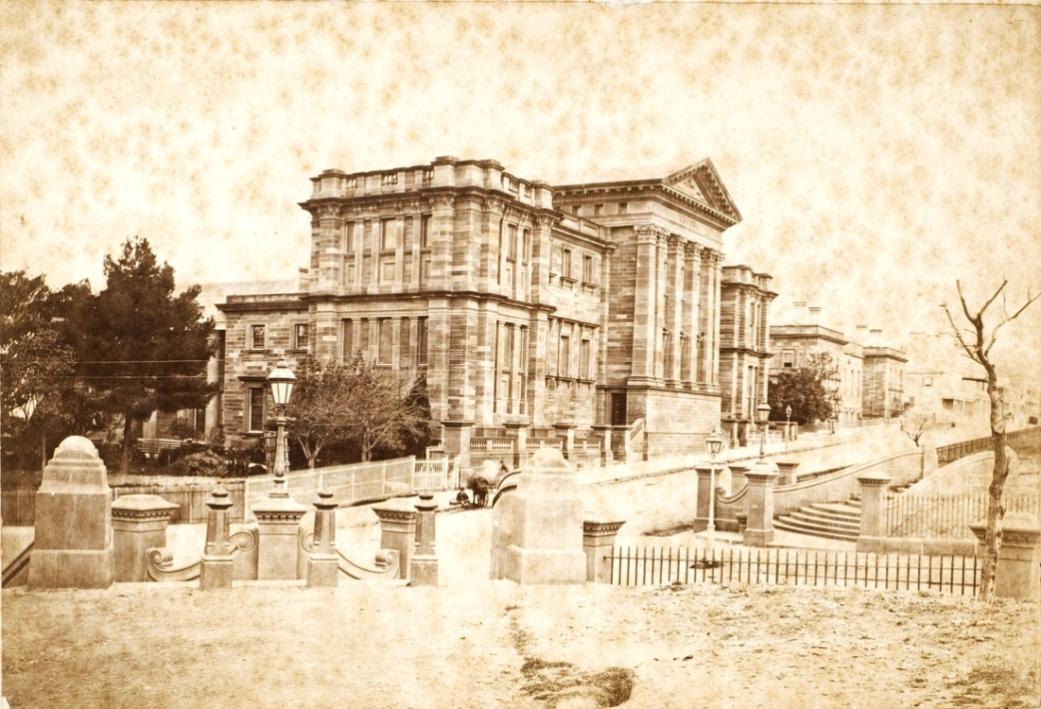Black-necked stork, Mycteria Australis, now endangered in NSW, Once Visited Pittwater

Male at Perth Zoo, Australia - photo by and courtesy JP Bennett from Yamato, Japan -
One example it is timely to share given the current push for expansion of the human species interests locally may bring the havoc we are wreaking much much closer to home.
In 1850 the first Australian Museum, going by that same name, was opened in Sydney amid innuendo:
THE AUSTRALIAN MUSEUM.—It is not generally known that the new building is opened. Thanks to the proceedings of the late Colonial Architect, some time must elapse before the whole of its interesting and valuable content can be exhibited to the public. Two apartments only, and those of small dimensions, are as yet finished, but the scientific and talented curator Mr. Sheridan Wall, has made the most of the limited space, as every one who visits the establishment on any Wednesday between 13 and o'clock will be unhesitatingly admitted. Among the sights to be seen are the splendid castes from the antique lately presented by Dr. Nicholson and those glorious perfections of sculpture the Venus de'Medicis, the Gladiators in the several positions, the Quoit Thrower, the Roman Slave Overhearing the Conspirators, Cupid and Pysche, The Adonis, the Apollo Belvidere, the Boxers and some other choice specimens are now within Australian gaze. The Casts of the fossil remains of the Dinrotodon, found some few year since beyond Moreton Bay have also been set up.
Out of doors in the Zoological collection there is the Tiger which has grown a very beautiful beast and become nearly as tame as beautiful, as also some few other live specimens added a few days since by the present of a Russian sheep from Captain Charlesworth, …
Apropos, of this building curious rumours are afloat to the effect that the worth of the materials employed in its erection is far below that which the Ex-Colonial Architect charged them at, and some with knowing shake of the head broadly hint the there are more Lewis's than he of London, who have a peculiar system of their own of shorthand.
LOCAL INTELLIGENCE. (1850, January 12). Bell's Life in Sydney and Sporting Reviewer (NSW : 1845 - 1860), p. 2. Retrieved from http://nla.gov.au/nla.news-article59770026
THE AUSTRALIAN MUSEUM.
To the Editors of the Sydney Morning Herald.
GENTLEMEN,-At the entrance to the enclosure which surrounds the Museum, it is intimated on a board very similar to the wooden placards Is conveying intelligence as to man-traps, sporting guns, or bloodhounds, with which some gentlemen, more exclusive than amiable, are in the habit of ornamenting their pleasure grounds, that visitors are, by order of the Committee, admitted to the Institution above named, one day in the week between the hours of 10 A M and 4PM
Can you inform the public what justification can be offered for this, apparently disgraceful arrangement in reference to what has cost that public so much there is certainly not much to be seen in the Museum, but what is there ought surely to be made reasonably accessible to the inhabitants of the colony, so that they may have the opportunity of obtaining whatever information, improvement, or gratification may be deniable from the inspection of this infant collection
I submit that this public institution ought to be open to the public every day of the week until six p M. The hours of school and of business are generally from nine or ten till four, and it is of great importance that young people and men engaged in business, should have it in their power to visit the collection after the engagements of the day are over.
M. Sydney, May 17. THE AUSTRALIAN MUSEUM. (1850, May 18). The Sydney Morning Herald (NSW : 1842 - 1954), p. 3. Retrieved from http://nla.gov.au/nla.news-article12918043
The short list above of items available in an 'Australian' museum meant people were encouraged to donate items of an Australian or associated island then, to fill the vast rooms continuing to be built. Donate they did. Multiple items being given, curious artefacts from those who had travelled to islands then spelled 'Feejee', shells, fish and it may be inferred caused the death and destruction of some creatures.
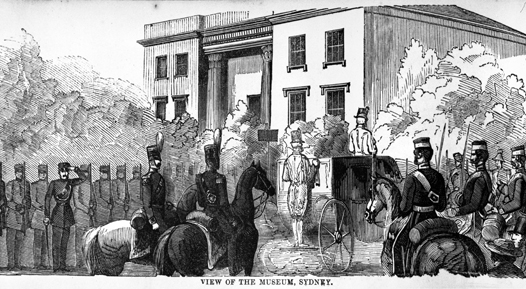
The arrival of the Governor-General Sir Charles Fitzroy to open the first exhibition at the Australian Museum in November 1854.
Many a bird was shot at Pittwater during the first decade of this esteemed edifices' opening - the lists, published monthly of who was donating what almost always list something from Pittwater and that something was usually alive prior to being shot and given to the museum. More than a few birds of waterways and bush tracks came from the Wheeler family.
Another bird, not seen here since, was shot, during breeding season for this species, and then what appears to be its mate was shot a few months later, during the nesting season.
That bird was, and is, the Black-necked stork, Mycteria Australis, a tall long-necked wading bird in the stork family - and in this instance, Australia's only stork:
DONATIONS TO THE AUSTRALIAN MUSEUM DURING APRIL, 1855.
A fine specimen of the male gigantic crane, Mycteria Australis, shot at a lagoon, near Pittwater. Mr. George Lamont, Pittwater. DONATIONS TO THE AUSTRALIAN MUSEUM DURING APRIL, 1855. (1855, May 7). The Sydney Morning Herald (NSW : 1842 - 1954), p. 5. Retrieved from http://nla.gov.au/nla.news-article12968963
DONATIONS TO THE AUSTRALIAN MUSEUM. JULY, 1855.
A mysteria Australis, or gigantic crane (female), shot at Pittwater-by Mr. George Mills, Bathurst-street. DONATIONS TO THE AUSTRALIAN MUSEUM. (1855, August 6). The Sydney Morning Herald (NSW : 1842 - 1954), p. 4. Retrieved from http://nla.gov.au/nla.news-article12972574
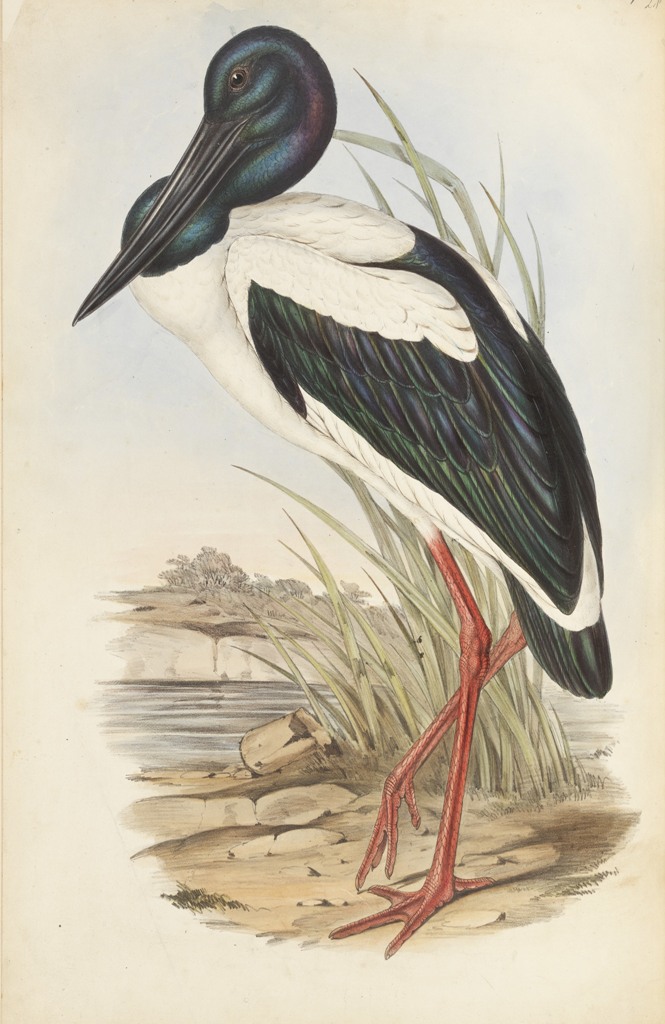
John Gould MYCTERIA AUSTRALIS: Vol 6 plate 51 of The Birds of Australia. Published date: 1848. Digital ID: IE4644479, courtesy State Library of NSW
The largest population of this species occurs in Australia, where it is found from the Ashburton River, near Onslow, Western Australia, across northern Australia to north-east New South Wales. It extends inland in the Kimberley area to south of Halls Creek; in the Northern Territory to Hooker Creek and Daly Waters; and in Queensland inland to the Boulia area and the New South Wales border, with some records as far south as the north-west plains of New South Wales, along the coast of Sydney and formerly bred near the Shoalhaven River.
The Shoalhaven River is a perennial river that rises from the Southern Tablelands and flows into an open mature wave dominated barrier estuary near Nowra on the South Coast of New South Wales, Australia.
The combined South and South-east Asian population is placed at less than 1000 birds. A 2011 study found the population in south-western Uttar Pradesh to be stable, although population growth rates may decline with an increase in the number of dry years or land use changes that permanently remove the number of breeding pairs. The Australian population has been optimistically estimated at about 20,000 birds while a more conservative estimate suggests about 10,000 birds. They are threatened by habitat destruction, the draining of shallow wetlands, overfishing, pollution, collision with electricity wires and hunting. Few breeding populations with high breeding success are known primarily due to lack of field work. It is evaluated as near threatened on the IUCN Red List.
The New South Wales Dept. of Environment & Heritage webpages on this magnificent bird (Profile and Listing for being gazetted 'endangered') state:
Conservation status in NSW: Endangered - Commonwealth status: Not listed
Gazetted date: 30 Jan 1998 - Profile last updated: 01 Dec 2017
Description
The Black-necked Stork is the only species of stork found in Australia. The distinctive black-and-white waterbird stands an impressive 1.3m tall and has a wingspan of around 2m. The head and neck are black with an iridescent green and purple sheen. The massive bill, short tail and parts of the wings are also black and the long legs are a conspicuous orange-red to bright red. The rest of the body is white. Females have a yellow eye, the males dark-brown. Juvenile birds are generally brown. Black-necked Storks are usually seen singly or in pairs in NSW, occasionally in loose family groups. In flight, they may intersperse their slow, heavy wingbeats with short glides, or soar on thermals. Storks are generally silent.
Distribution
The species Ephippiorhynchus asiaticus comprises two subspecies, E. a. asiaticus in India and south-east Asia, and E. a. australis in Australia and New Guinea. In Australia, Black-necked Storks are widespread in coastal and subcoastal northern and eastern Australia, as far south as central NSW (although vagrants may occur further south or inland, well away from breeding areas). In NSW, the species becomes increasingly uncommon south of the Clarence Valley, and rarely occurs south of Sydney. Since 1995, breeding has been recorded as far south as Buladelah.
Habitat and ecology
- Floodplain wetlands (swamps, billabongs, watercourses and dams) of the major coastal rivers are the key habitat in NSW for the Black-necked Stork. Secondary habitat includes minor floodplains, coastal sandplain wetlands and estuaries.
- Storks usually forage in water 5-30cm deep for vertebrate and invertebrate prey. Eels regularly contribute the greatest biomass to their diet, but they feed on a wide variety of animals, including other fish, frogs and invertebrates (such as beetles, grasshoppers, crickets and crayfish).
- Black-necked Storks build large nests high in tall trees close to water. Trees usually provide clear observation of the surroundings and are at low elevation (reflecting the floodplain habitat).
- In NSW, breeding activity occurs May - January; incubation May - October; nestlings July - January; fledging from September. Parents share nest duties and in one study about 1.3-1.7 birds were fledged per nest.
- The NSW breeding population has been estimated at about 75 pairs. Territories are large and variable in size. They have been estimated to average about 9,000ha, ranging from 3,000-6,000ha in high quality habitat and 10,000-15,000ha in areas where habitat is poor or dispersed.
Black-necked stork - endangered species listing
NSW Scientific Committee - final determination
The Scientific Committee, established under the Threatened Species Conservation Act 1995, has made a Final Determination to list Ephippiorhynchus asiaticus(Latham, 1790), Black-necked Stork as an ENDANGERED SPECIES in Part 1 of Schedule 1 of that Act and, as a consequence, to omit reference to that species as a vulnerable species from Schedule 2 of that Act.
The Scientific Committee has found that:
1. The Black-necked Stork is a large glossy black and white stork with very long red legs and a large straight black bill. Its core distribution is northern Australia, although it does not occur in enormous numbers anywhere within Australia.
2. In eastern Australia the Black-necked Stork has been recorded as far south as Victoria and inland to the Macquarie Marshes and Griffith. Since European colonisation the range of this species has declined slightly to the north and east. The number of individual birds recorded on the southern and western limits of this range has declined significantly, with only occasional individuals recorded on the South Coast or west of the Great Dividing Range during favourable conditions.
3. Until the 1970s Black-necked Storks bred regularly, although in small numbers, as far south as Shoalhaven Heads. No breeding observations have been recorded south of Port Stephens for a number of years.
4. Black-necked Storks continue to breed in the northern NSW river valleys, however few nests occur within each valley. Most are located in less accessible locations or where disturbance is minimal. The species is thought to have a low tolerance of disturbance.
5. Clearance of remnant vegetation patches and individual trees constitute one of the major threats to the Black-necked Stork in NSW. The difficulty in detecting nests means that some are destroyed before their presence is detected. The scarcity of nest sites has resulted in competition for those that are available with other bird species.
6. Wetland modification also threatens this species and although artificial water sources can provide areas of new habitat these are often suboptimal for the Black-necked Stork.
7. Powerlines constitute a considerable threat to the Black-necked Stork, and several birds are killed or injured as a result of collisions with the lines each year. The few birds actually affected comprise a high percentage of the total population within each river valley.
8. In view of 2, 3, 4, 5, 6 & 7 above the Scientific Committee is of the opinion that the Black-necked Stork Ephippiorhynchus asiaticus is likely to become extinct in nature in NSW unless the circumstances and factors threatening its survival cease to operate, and that transfer from Schedule 2 to Part 1 of Schedule 1 is justified.
It was extinct in Pittwater after July 1855; no other records of one, or a pair being sighted, have been found as yet. A pair of these great birds will bond for many years and sometimes may stay together for life. As we humans now know a little more about the breeding cycle of this bird; if the female shot in July 1855 was nesting her eggs would not have hatched, or if there was already one of two chicks in this pairs' nest, they would have starved to death.
The location of 'a lagoon near Pittwater' is either Narrabeen or perhaps was the verges of Bayview when that was still more wetland than filled in land. It may even have been the Black Swamp at Mona Vale, a remnant of which you can see as a bird-attracting pond mid fairway at Mona Vale golf course, or even further along at Newport which also once had its own lagoon. As it was 'near Pittwater' and Narrabeen lagoon was known of by then, the description points towards water bodies once here that have also, through human design, disappeared from our landscapes.
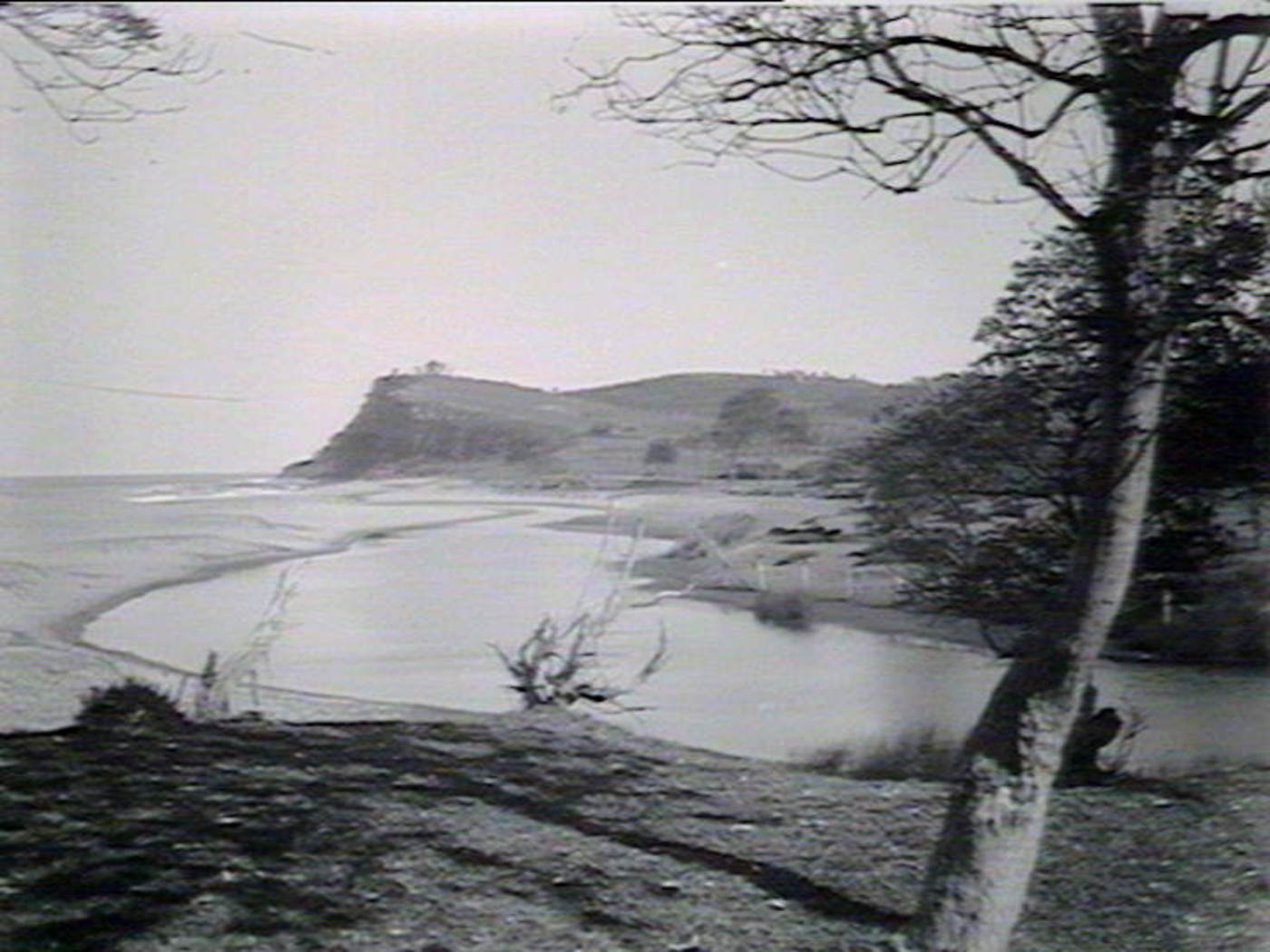
Farrells Beach and Bungan Head, 1912 - Government Printing Office 1 - 12148. Image No.: d1_12148h, courtesy the State Library of New South Wales.
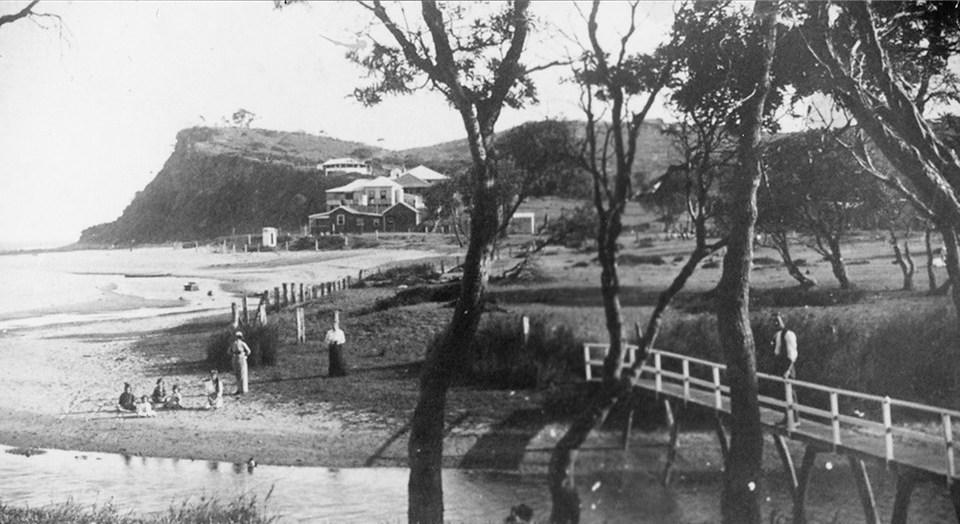
A CREEK AT NEWPORT BEACH, (Photo: C. S. Harnett.)
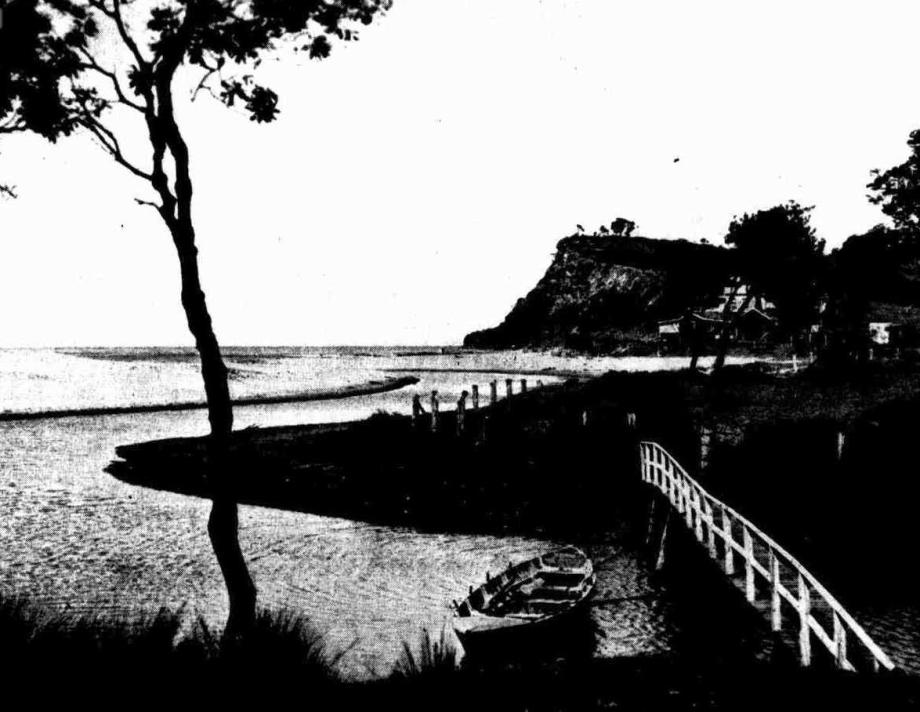
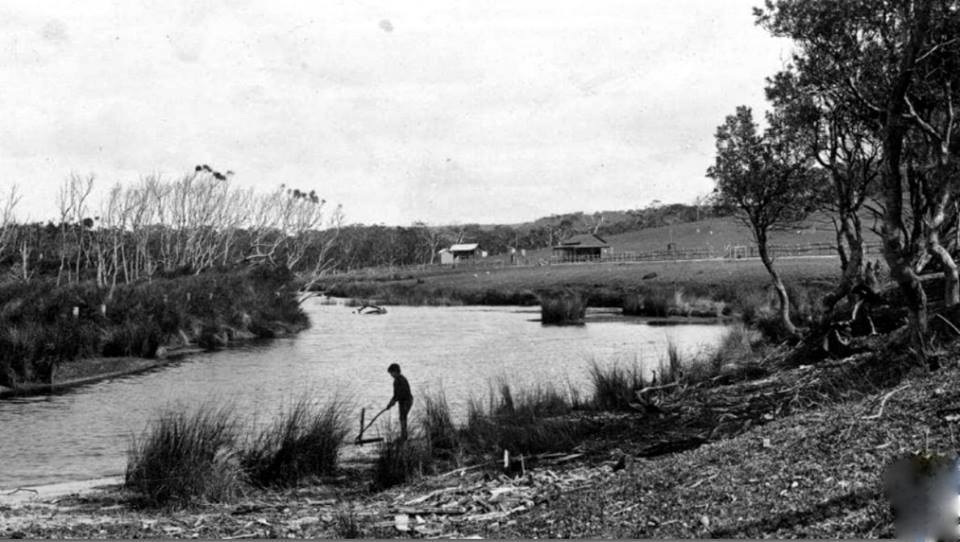
Our ceaseless quest for knowledge, our arrogance in thinking ourselves worth more than everything else, has clearly already lost us many of the prizes we seek to attain through such practices.
Nowadays, and for at least two generations, some are using the words 'save it for future generations' in our attempts to plug a finger in the hole of mass extinctions. This one already lost opportunity underlines that the generations between 1855 and those who took up the torch of being custodians so their grandchildren could stand and look up at a giant tree have already missed out on seeing a few things themselves.
This makes you wonder how clever those gentlemen who killed these birds would feel if they knew what their actions had borne as our fruit. Generations on, as another species gets closer to extinction without us really knowing as much about it as we should, we must wonder what else we don't know about what is fast disappearing, and perhaps even wonder what may be disappearing without us knowing they exist at all.
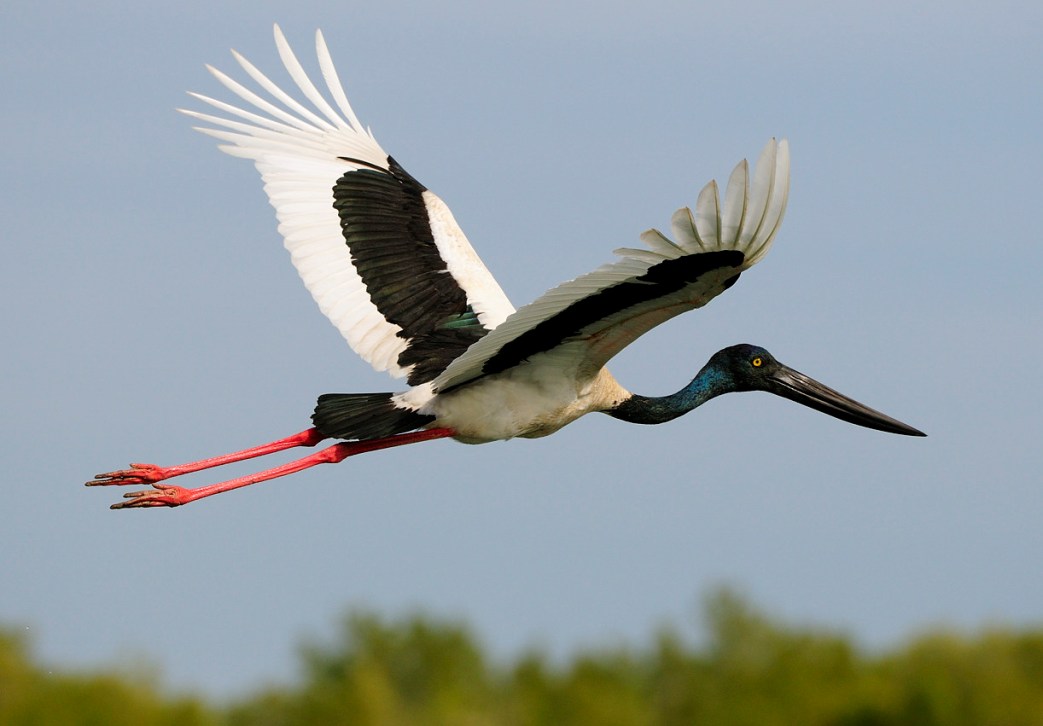
Adult female in flight at the McArthur River in the Northern Territory of Australia. Photo by and courtesy Djambalawa
Also SHOT or captured at Pittwater
AUSTRALIAN MUSEUM Donations during the month of May
A black swan (cygnus atratus) shot near Pittwater. Presented by Mr. John Mills AUSTRALIAN MUSEUM. (1854, June 6).The Sydney Morning Herald (NSW : 1842 - 1954), p. 5. Retrieved from http://nla.gov.au/nla.news-article12955624
An iguana and white throated goatsucker (Eurystopodus albogularis), from Pittwater ; presented by John Gray, Esq. DONATIONS TO THE AUSTRALIAN MUSEUM DURING OCTOBER, 1854. (1854, November 6). The Sydney Morning Herald (NSW : 1842 - 1954), p. 5. Retrieved from http://nla.gov.au/nla.news-article12957364
Mr. JAMES WHEELER.-A female Lyre Bird (Menuro Superba.) from Pittwater. An enormous eel (anguilla brevirostris), taken out of the main water-pipe in Lower George-Street ; its extreme length is 4 feet 9 inches, and its girth 13 inches. George Wilson, Esq. DONATIONS TO THE AUSTRALIAN MUSEUM DURING AUGUST, 1856. (1856, September 8). Empire (Sydney, NSW : 1850 - 1875), p. 5. Retrieved from http://nla.gov.au/nla.news-article64976083
A specimen of a rare Tringa (Sandpiper), shot at Pittwater. By George Mills. DONATIONS TO THE AUSTRALIAN MUSEUM DURING APRIL, 1857. (1857, May 5). The Sydney Morning Herald (NSW : 1842 - 1954), p. 5. Retrieved from http://nla.gov.au/nla.news-article12995114
A White Heron (Herodias syrmatophorus) from Pittwater, by Mr. James Wheeler, St. Leonard's. DONATIONS TO THE AUSTRALIAN MUSEUM DURING SEPTEMBER, 1858. (1858, October 8). The Sydney Morning Herald (NSW : 1842 - 1954), p. 5. Retrieved from http://nla.gov.au/nla.news-article13016767
A Lyre Bird (Menora Superba), shot at Pittwater: By Mr. George Buchanan, 113, Crown. street, Woolloomooloo. LIST OF DONATIONS TO THE AUSTRALIAN MUSEUM, DURING AUGUST, 1860. (1860, September 10). Empire (Sydney, NSW : 1850 - 1875), p. 4. Retrieved March 4, 2018, from http://nla.gov.au/nla.news-article60497943
LIST OF DONATIONS TO THE AUSTRALIAN MUSEUM DURING JANUARY, 1861.
A wallaby, shot at Pittwater. By Mr. James Buchanan, 230, Liverpool-street. Twenty-five specimens of fish from the Australian coast. By Mr. T. Ireland, Jnr., Woolloomooloo Bay. A South Sea Island parrot (Psittacosis). By Mr. William Beaumont, Botany. A war club from the Feegee Islands. By Master Bray, 160, Pitt-street. LIST OF DONATIONS TO THE AUSTRALIAN MUSEUM DURING JANUARY, 1861. (1861, February 14). The Sydney Morning Herald (NSW : 1842 - 1954), p. 4. Retrieved from http://nla.gov.au/nla.news-article13052647
AUSTRALIAN MUSUEM Donations during the month of October 1862
A diamond snake (Morelia apílalo) : by Mr. George Lush, Pittwater. AUSTRALIAN MUSEUM. (1862, December 9).Empire (Sydney, NSW : 1850 - 1875), p. 5. Retrieved from http://nla.gov.au/nla.news-article60520006
And one more crane strays into:
A gigantic crane, or " jabiru" (Mysteria Australis), By the Director of the Botanic Gardens. LIST OF DONATIONS TO THE AUSTRALIA MUSEUM, DURING MARCH, 1869. (1869, May 11). The Sydney Morning Herald (NSW : 1842 - 1954), p. 2. Retrieved from http://nla.gov.au/nla.news-article13189981
There are more.
AUSTRALIAN SPOTTED GOATSUCKER.
This handsome twilight bird is found in almost every part of temperate Australia-from Swan River to the coast of New South Wales ; it generally appears soon after sun-down chasing the large moths and other night insetcs. Its movements when on the wing are very graceful ; and so noiseless is the flight of this bird, that a person would not notice a sound, should the Goat-sucker be passing within a few yards.
The inappropriate name has been given to the European species many centuries ago, from the belief that- this Night Swallow, which occasionally hovers over herds of goats or cattle, (for the sake of catching the insects generally found near them,) was in the habit of milking the farmers' property. The single egg which this bird deposits-without nest-on the bare ground is of the size and color of a Partridge's egg, but sparingly spotted with black dots as largo as a pin's head. An egg of this kind was found in 1861 not far from the Pittwater road, in the middle of a stony bush-track ; another egg has been presented to the museum by Mr. Allan, of Kirnbricki, Manning River. These two eggs are the only pair known, and they will be figured in Mr. Ramsay's forthcoming work on the eggs of Australian birds. The scientific name is Surastopodus guttatus.
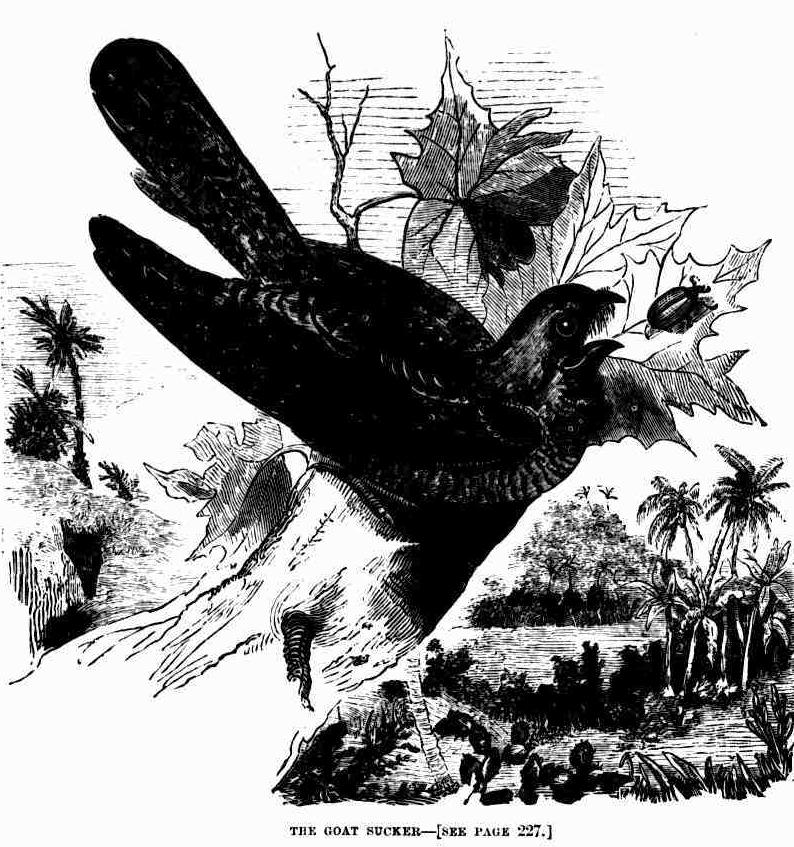
THE GOAT SUCKER
[SEE PAGE 227.] AUSTRALIAN SPOTTED GOATSUCKER. (1867, September 16). Illustrated Sydney News (NSW : 1853 - 1872), p. 3. Retrieved from http://nla.gov.au/nla.news-article63513646
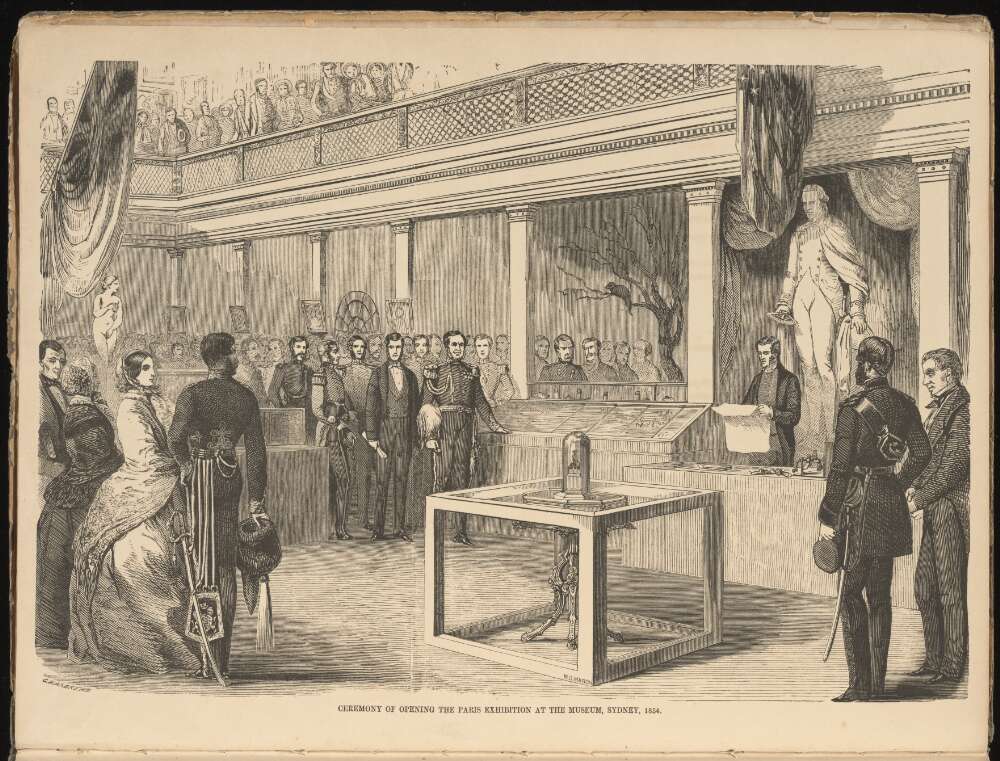
Ceremony of opening the Paris Exhibition at the Museum, Sydney, 1854 [picture] / C.W. Andrews; W.G. Mason. Created/Published [Sydney : J.R. Clarke, 1857] 1 print : wood engraving ; 22.8 x 33.6 cm nla.obj-138446743-1 Courtesy National Library of Australia.
AUSTRALIAN MUSEUM.
NOTICE is hereby given, that on Thursday, March 3rd 1859, George Bennett, Esquire, vacated the office of Elective Trustee of the Australian Museum, by resignation.
And notice is also given, that on Thursday, April 7th 1859, the following Candidate for the office of Elective Trustee, was, according to the 8th by-law of the Australian Museum, duly chosen by ballot to fill the above-mentioned vacancy, viz:—Sir Charles Nicholson.
By order of the Board of Trustees,
E. DEAS THOMPSON,
Chairman. Australian Museum,
9th April, 1859.
AUSTRALIAN MUSEUM. (1859, April 12).New South Wales Government Gazette (Sydney, NSW : 1832 - 1900), p. 819. Retrieved from http://nla.gov.au/nla.news-article228716397
The Australian Museum becomes bigger than two rooms and a cage for an unfortunate tiger:
THE AUSTRALIAN MUSEUM
To New South Wales belongs the credit of being the first of the Australian Colonies to establish a public museum; and judging from the number of visitors, of whom there were 35,000 last year, the public appreciate the value of the institution.
The foundation of the Australian Museum was laid in December, 1846; and the building was opened to the public in August, 1860. It is 108 feet in length, 64 feet in depth, and 50 feet high, and contains a museum room 103 by 35 feet, with a gallery all round; quarters for the curator and a large basement.
The limited space at present at the disposal of the trustees prevents their making that complete arrangement of the specimens that would be desirable and at the same time most instructive to the public. As far as possible, the curator, Mr. Kreeft, a naturalist of no mean repute, has carried out the system 0f classification adopted in the British Museum, but, from the cause before stated, some very fine specimens are at present packed away in the cellar.
The addition to the Museum, the walls and roof of which are nearly completed, is intended to afford accommodation for the constantly increasing collection of specimens in this popular institution, and to admit of their better and more convenient classification and arrangement. The new wing has a frontage to Hyde-park upwards of 200 feet in length, with a return at each end towards the old building of about 45 feet. The general height is about 60 feet but the central pediment is more than 80 feet above the street level. The walls are built entirely of sandstone from the Pyrmont quarries, the external face of the work being rubbed.
The style of architecture is Roman, monumental in treatment and of a bold character, suitable for public edifices of this class, the nature of the site—which has a considerable fall towards William-street, and is on a lower level than the opposite portion of Hyde-park, together with the extent of frontage, visible on all sides for a considerable distance—rendered it necessary that the style adopted should be characterised by simplicity of detail. It was also necessary to incorporate the present building, which will ultimately have a story added to it, and be otherwise altered so as to harmonize with the new addition. The new wing has not a great deal of ornamental decoration ; but at a future day the panels under the windows in the wings, the spaces under the windows of the curtains, and on the central stylobate, will afford opportunity to local sculptors to display their talents in bas-reliefs, illustrating the progress of science. The tympanum of the pediment, and the pedestals on the parapet, also, are available for sculpture in full relief.
The general contract for the works, now nearly completed, has been carried out by Messrs. A. S. Loveridge, assisted by Messrs. Smith and Bennett. To Mr. W. McGill, the contractors entrusted the execution of the Corinthian capitals, the lions' heads, and the pateral of the cornice. For the other ornamental portions Messrs. Hinton, Abrahams, and others, were employed. The whole work has been executed in a substantial and credit-able manner, under the care of the contractors' foreman, Mr. M. Fawcett and Mr. R. Anson, and the entire cost has not exceeded £20,000.
The internal arrangements, for which at present no funds have been voted, will comprise a lofty central Hall, 50 feet by 46 feet, on the ground floor, with compartments, on each side, separated by open screens of Corinthian columns,-and forming a continuous gallery 200 feet in length, communicating witlrthe present building-this arrangement having been adopted to obtain easy and economical supervision of the collection, as well as to enhance the architectural effect.
From the central Hall the first floor will be reached by a staircase of ample dimensions and suitable' character; the arrangements will Be similar to that of the ground floor, the .Hall being very lofty and lighted by windows in the external frieze. On both floors light galleries will be carried round fire walls, on which cases will be placed between the windows. Ample provision is made for efficient ventilation.
The only portions of the internal work yet executed are the joisting of the first floor and the wrought-iron girders supporting the same; these girders were the first of their kind made in the Colony, and are from the workshop of Mr. W. Penny, at the Glebe.
The designs for the building -and its details are by Mr. J. Barnet, the acting Colonial Architect, and the Work has been carried out under his personal superintendence, with the assistance in the second contract of Mr. J. Sharkie, foreman of works.
It was the intention of the late Government to devote a portion of the new building to the purposes of a public library ; whether this design will be adopted by their successors it is at present impossible to say.
The Museum is open to visitors every day from twelve till four.
THE AUSTRALIAN MUSEUM. (1864, June 16). Illustrated Sydney News (NSW : 1853 - 1872), p. 1. Retrieved from http://nla.gov.au/nla.news-article63514856
